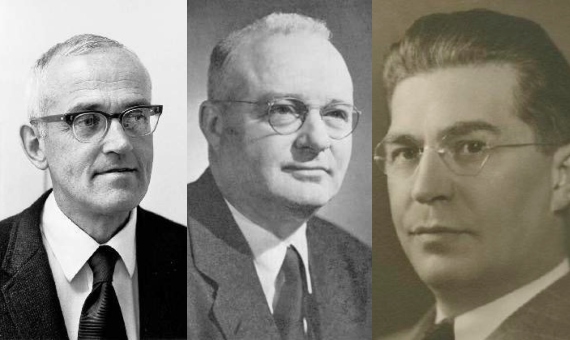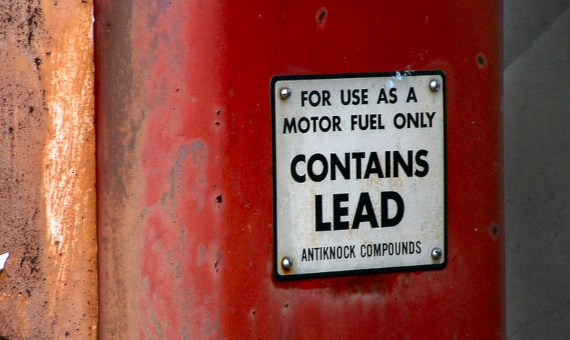In all fiction there is never a hero without a villain, nor vice versa. Real life, on the other hand, is usually more nuanced and seldom so black and white. However, in the realm of science, where data has a voice, we sometimes come across cases that actually fit the archetype of the good guy and the bad guy quite closely. Given that at OpenMind we have already profiled Thomas Midgley, the harmful inventor of two scourges of humanity—leaded gasoline and chlorofluorocarbons (CFCs)—his nemesis, Clair Patterson, who helped rid the world of the former, deserves no less attention. And although in scientific disputes archenemies rarely engage in face-to-face battles, or even meet each other, their struggles are no less epic.
Like a Superman dropped from the sky in Smallville in rural America, Clair Cameron Patterson (2 June 1922 – 5 December 1995), the son of a mailman from Mitchellville, Iowa, might have seemed an unlikely superhero. But if the fictional extraterrestrial from the planet Krypton is known for saving the world, Patterson’s contribution could not be described as anything less significant. And while Clark Kent’s alter ego was able to reverse time, the Iowa chemist did something far more astonishing because his feat was real: he calculated how long the Earth has existed.
From the Manhattan Project to analyzing meteorites
Beyond his precocious interest in science and a keen intelligence that propelled him at full speed through elementary school, Patterson’s beginnings did not seem particularly unique. As a young chemist specialising in molecular spectroscopy, Uncle Sam spared him from service in World War II because it believed his contribution would be more valuable running a mass spectrometer for something called the Manhattan Project. Patterson’s job was to separate the scarce uranium-235 from the more abundant uranium-238 because the former powered the bomb. Like many others, he was horrified by the results of his work.
Returning to civilian life, Patterson enrolled for a PhD at the University of Chicago, where his supervisor, Harrison Brown, had an idea. Almost from the beginning of the 20th century, the uranium-lead method of dating minerals had been used. Over geological time scales, the former decays radioactively to produce the latter, and the ratio of the two can date the age of rocks, like a sort of atomic clock. However, Brown had an even more ambitious goal in mind: to accurately calculate the age of the planet Earth itself, which was then estimated to be about 3.3 billion years old. He had the technology, the mass spectrometry technique and, with the arrival of Patterson, someone skilled and outstanding enough to take on the job.

Patterson was assigned to team up with fellow graduate student George Tilton to undertake a challenging mission never before attempted: dating pinhead-sized minerals from meteorites—true relics from the birth of the Solar System. The work was divided between them: Tilton measured the uranium, while Patterson analysed the lead. However, for iron meteorites in which uranium was virtually non-existent, and to avoid any errors due to interference from common lead of non-radiogenic origin, Brown encouraged Patterson to develop a lead-lead dating technique, since distinct lead isotopes come from different uranium isotopes. This made it possible to calculate the age of a rock by knowing the relative amounts of lead isotopes, including the correction for lead-204, the primordial non-radiogenic lead isotope.
Lead here, lead there… Lead everywhere
However, something soon emerged that made Patterson’s work even more difficult. While his colleague Tilton was obtaining the expected levels of uranium, the lead values he was measuring were shooting off the scale, even in samples in which no lead should be found at all. “I found out there was lead coming from here, there was lead coming from there; there was lead in everything that I was using,” Patterson recalled.
It was then that his obsession began to take hold. In his former lab in Chicago and, from 1953, having achieved a PhD, at his new facility at Caltech (California), Patterson created one of the first clean rooms in history: he changed the pipes, filtered the air, sealed the entire room, washed the smallest utensil with acid, wore special suits, and even distilled all the chemical reagents shipped to him. No one was permitted to enter his laboratory; a visitor’s hair or speck of dandruff could contaminate the space with lead.

The source of that contamination was no mystery. Patterson knew that he lived in the age of lead. At that time, this metal was found everywhere: in pipes, paints, glass, household utensils, tin cans and even toys. Most of all, it was present in automobile exhaust. Gasoline containing tetraethyl lead, an additive to prevent engine knocking, had been developed by Midgley when Patterson was still a baby, and the inventor was already deceased by the time Patterson ordered his assistants to wipe the laboratory floor with damp towels every day.
An epic fight against the most powerful industry
But another scientist would inherit Midgley’s work. Midgley’s former boss at General Motors, Charles Kettering, hired pathologist Robert Kehoe and gave him a mission: to prove that exposure to low levels of lead was safe and to exonerate the companies producing leaded gasoline from blame for the deaths and brain damage that had been plaguing fuel plant employees.
Thus the real epic struggle was actually not Patterson versus Midgley, but Patterson versus Kehoe. While Kehoe devoted his entire research and career to whitewashing the harmful effects of lead exposure (generously funded by the oil companies), to monopolising the role of the sole medical expert on the toxicology of lead for over 40 years, and to collecting honours and posts from industry, his nemesis Patterson travelled the world by land, air and sea to collect environmental samples from surface water, deep water, marine sediment, snow-capped peaks, Arctic and Antarctic ice and even Peruvian and Egyptian mummies, only to discover that the planet had become one big ball of lead: its concentration in the atmosphere was more than 1000 times above natural levels, and 100 times in the human body itself, a figure he later corrected to 600.

While Kehoe never changed his position, Patterson was ignored and ridiculed for years until finally, in 1976, the US Environmental Protection Agency—as a precaution—mandated a reduction in the levels of lead in gasoline, which were incompatible with the new catalytic converters designed to lower particle emissions. But it was not until the 1980s that Patterson’s work was accepted and his data recognised. 1986 marked the beginning of the end of leaded gasoline, which disappeared from all filling stations in the US on 31 December 1995, weeks after an asthma attack ended Patterson’s life. Since then, as prohibitions on leaded gasoline spread across the globe, lead levels in the atmosphere, the environment and the human body have fallen dramatically, especially in high-income countries. However, blood lead levels remain a problem today in some low- and middle-income countries mainly from sources other than leaded gasoline.
And in the midst of all this, Patterson finally achieved his original goal of calculating the age of the Earth using fragments from the Canyon Diablo meteorite (Meteor Crater, Arizona): 4.550 billion years, a figure still considered valid today. According to some chronicles of the time, after the publication of that work, an evangelist who believed in creationism knocked on his door to politely inform him that he was going to hell.
Comments on this publication